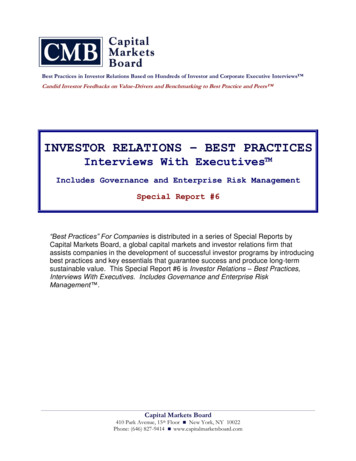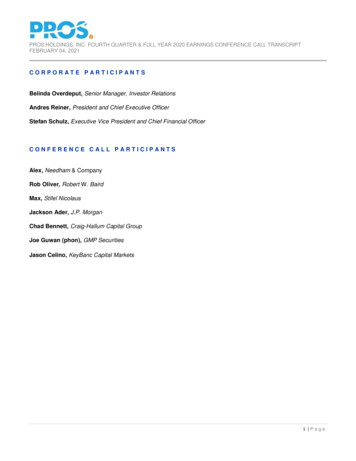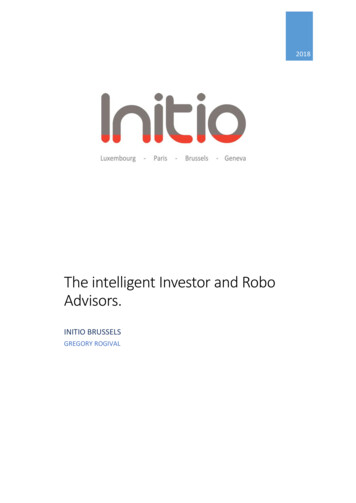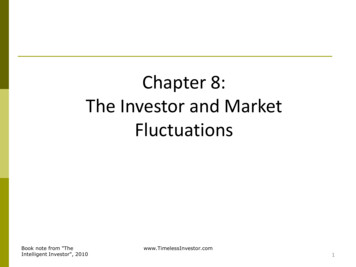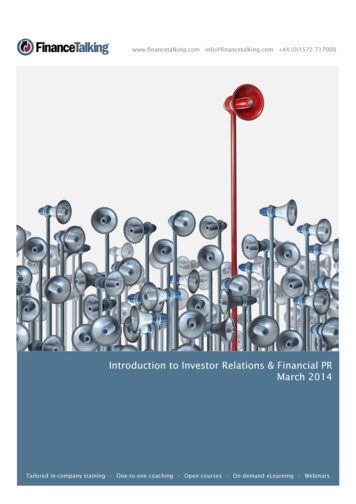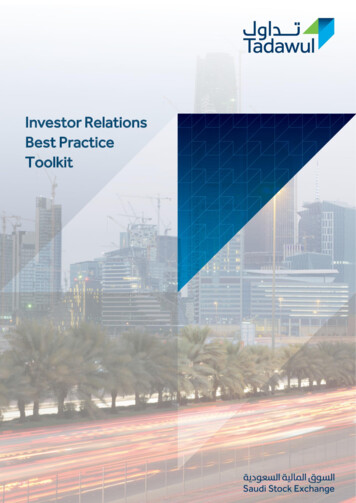
Transcription
Investor RelationsBest PracticeToolkit1
ForewordThe aim of this Investor Relations Best Practice Toolkit is to provide information, advice andsupport to all companies either listed on or about to list on Tadawul. It outlines the key principlesof international best practice and provides an explanation of the benefits of following thesestandards.Most importantly, the Toolkit was created with the ambition to become an invaluable practicalguide to all professionals handling investor relations for a company listed on the Saudi StockExchange, inspiring them to go beyond the regulatory requirements and raise the bar in theirrespective market or sector.Over the past 18 months, Tadawul has implemented numerous measures to enhance theeffectiveness of the capital market, foster an attractive investment environment for local andinternational investors and further optimise its regulatory framework.As the first publication of its kind in the Middle East, this Toolkit marks yet another milestone onTadawul’s journey towards establishing itself as an active player in global capital markets,building on its current role as the leading regional stock exchange.We hope the Toolkit, which will be updated on a regular basis, will become a trusted source ofreference for its readers. If you have feedback or suggestions, we look forward to hearing fromyou at csc@tadawul.com.sa.Further information on Tadawul and the markets it operates can be found in the 2018 ListingGuide.Tadawul (Saudi Stock Exchange)July 20182
ContentsPage1. Introduction to investor relations1.11.21.3What investor relations isWhy it is importantWhat makes effective investor relations1.3.1 Fundamental principles1.4 Benefits of effective investor relations1.5 Key investor relations responsibilities1.5.11.5.21.5.31.5.4Managing (and aligning) expectationsControl of information flowDevelopment of investor relations strategy and programRegulatory compliance1.6 Allocation of resources1.7 Internal positioning of investor relations1.8 Capital markets spokespersons6678910101010111112122. Investor relations audiences2.1 Institutional investors142.1.1 Income investors2.1.2 Value investors2.1.3 Growth investors14141415152.22.32.42.52.63Retail investorsAnalystsDebt investor relationsMediaInternal audiences161717
3 Building the investor relations program3.1 Investor relations objectives3.2 Best practice investor relations program183.2.1 Structured, periodic .1.73.2.1.83.2.1.93.2.1.103.2.1.11Message developmentShareholder identification / investor targeting3.2.1.2.1 Shareholder ID3.2.1.2.2 Investor screening and targetingFinancial results3.2.1.3.1 Preparation for results3.2.1.3.2 Results day3.2.1.3.3 Post-results day activities3.2.1.3.4 Earnings announcementsOther information materials3.2.1.4.1 Earnings presentations3.2.1.4.2 Other presentations3.2.1.4.3 FactsheetsAnnual reportWebsite3.2.1.6.1 Example of best practice IR websiteConsensus collection and analysisRoadshowsCompany / Site visitsPerception researchBenchmarking studies2020212224252527272828293030313334353.2.2 Day-to-day operations3.2.2.13.2.2.23.2.2.3Maintaining market intelligence3.2.2.1.1 Regular contact with analysts and investors3.2.2.1.2 Regular contact with journalists3.2.2.1.3 Monitoring of the financial mediaDatabase development / maintenance3.2.2.2.1 Analysts and investors (and journalists)3.2.2.2.2 Q&ASocial media3.2.2.3.1 Purpose3.2.2.3.2 Policy overview3.3 Crisis communications3.4 Example IR program4353636363636373839
4. Relevant Rules and Regulations4.1 Key principles404.2 Key concepts4.2.1 Market misconduct414.2.2 Fair and non-selective disclosure414.2.3 Price sensitive information424.3 Disclosure obligations4.3.1 When to disclose price sensitive information434.3.2 Standing insider list and identification of insiderinformation434.3.3 External advisors444.3.4 Monitoring of security prices, and market rumours444.3.5 Non-public commercially sensitive information454.3.6 Training455. Measuring the value of investor relations546
1Introduction to investor relations1.1What is investor relationsThe managers of a listed company are responsible to its shareholders as owners of thecompany for the company’s activities under the guidance of the board of directors. Althoughthe shareholders do not usually take an active part in the day-to-day management of thecompany, they have the right to understand how the company is performing. These rightsare expressed in the regulatory obligations laid upon listed companies.It is the role of investor relations (IR) to be the interface between the company and itsinvestors. More broadly, investor relations is the channel for two-way communicationsbetween a company and the financial markets as a whole. Investor relations should not justbe a one-way mouthpiece for a company; it should also provide the company with essentialfeedback from investors and the wider market as to their views on the company in terms ofits performance, strategy and outlook. Used wisely, this intelligence can: a) provide valuableinput to a company’s strategic decision-making; whilst b) maximising the effectiveness of itscommunications by tailoring it to any existing or emerging concerns of the markets.Effective IR differs from public relations and/or marketing as it should aim to provide a fairunderstanding of a company’s strategy and business to actual and potential investors, toallow for balanced and informed judgements to be made. This contrasts with PR/marketing,which usually aims to present a company’s products and services in the most favourable lightpossible.1.2Why it is importantFor financial markets to function efficiently, there must be a flow of information from listedcompanies to the market. The price of a company’s shares reflects the performance of thecompany and expectations of the market about its future results. In order properly to assessperformance and to understand the factors affecting its results, the market needs to be fullyinformed by the company about all relevant information.Strict regulatory provisions exist to ensure that listed companies make the necessarydisclosures.1.3What makes effective investor relationsOne of the fundamental driving forces of financial markets is confidence. This applies both atthe macro level for markets and at the level of individual companies. Confidence in acompany’s future performance will depend on the management of market expectationsabout it. These expectations are shaped by the way in which a company communicates.To be effective, investor relations must communicate in a consistent, comprehensive andaccurate manner. Achieving these objectives over time will enhance the credibility of thecompany, which in turn will build trust, leading to confidence in its management andprospects.Credibility and trust are reinforced by the quality of the relationship between the companyand the shareholder. This means that the company must go beyond the minimum regulatoryrequirements and understand the needs of shareholders for additional information and6
explanation. It means responding quickly to investor questions and making seniormanagement available to investors at appropriate times.Effective investor relations is not only a matter of building investor relationships, but usingthose relationships to create a good understanding of the company’s future opportunitiesand growth potential. It means clearly differentiating the company’s story from competinginvestment opportunities.Key hallmarks of effective investor relations include: Distinctive profile among the investment community Good understanding of the company’s future opportunities and growth potential by themarket Clear differentiation of the company’s story from competing investment opportunities Demonstration of the strength of management Trust and confidence in management Encouragement of sell-side analyst coverage Broadening of the shareholder base Improved levels of liquidity in the company’s shares Consistent and fair valuations Easier and cheaper access to capital in the futureWhat effective investor relations is NOT about: Marketing spinSelective disclosure (see 4.2.2 Fair and non-selective disclosure)A short-term undertakingSubstitution for poor managementOne-way communication from a company to the marketMaximising the share price, but seeking a full and fair valuationAlthough share price out-performance may be desirable, it cannot in itself be an objective,because: a) there are too many external factors outside the control of the investor relationsdepartment that affect it; and b) encouraging an overvalued share price not necessarilysupported by fundamentals can lead to false expectations that are hard to sustain, leading toadverse implications in the longer term including loss of credibility which a company maystruggle to rebuild.7
1.3.1 Fundamental principles:Best practice investor relations has five fundamental underlying principles, the 5 Cs:Effective IRCommitmentConsistencyCredibilityClarityConduitof board ofdirectors andtopmanagement toIRtalk in goodtimes and badIROs need to beauthoritativespokespersonsmessage,strategy, keypointsto be a two-wayflow ofinformation81CommitmentSupport and commitment from the top is essential to establishing credibility within themarket and instilling the ‘right’ culture throughout the company.2ConsistencyAvoid gloss and spin by being prepared to communicate in bad times as well as in goodtimes. There also needs to be consistency of the messaging in order to optimiseeffectiveness and reinforce credibility.3ClarityMessages need to be both precise and succinct.4ConduitEffective investor relations is all about two-way communication: both speaking andlistening to the market, thereby helping to minimise the information disconnect.5CredibilityIn order to act as an authoritative spokesperson for a company, investor relations needsto have credibility both externally (with the market) and internally (with a company’sexecutive management and across functions).
1.4Benefits of effective investor relationsBeyond complying with legal obligations in terms of communicating with its shareholders and thewider financial markets, effective investor relations can also bring benefits to the company.A full and fair market valuation for a company should be the principal objective of effectiveinvestor relations, and this is achieved through minimising the perceived cost of capital.Lowering the cost of capital should make it easier to raise capital through equity markets in thefuture, and/or undertake an acquisition using a company’s shares as currency.Investor relations can bring stability to the share price, minimising volatility and giving greaterpredictability to a company’s valuation as a basis for strategic planning. It can also supportstability in the shareholder base, meaning that the company’s strategy will be supported by aloyal group of core investors.Good practice in investor relations can create a virtuous circle of effects. An interesting, positiveand developing investor proposition will lead to enhanced levels of liquidity in the stock, whichwill help to support a fair market valuation, providing a company with easier and cheaper accessto capital, thereby reinforcing the investor proposition and broadening and solidifying thesupport of its core shareholders.Reasonablelevel ofliquidityStronggroup ofsupportersand believersEffective IREasier andcheaperaccess tocapital in thefuture9Full and fairmarketvaluation
1.5Key investor relations responsibilities1.5.1 Managing (and aligning) expectationsManaging market expectations is a key element of investor relations. Of necessity, investors donot have ‘inside’ knowledge of the state of a company’s business and this creates a gap inperceptions between management and investors about the company’s performance, which canbe difficult to address if that gap widens.Expectations are set and managed through a clear, comprehensive and consistent two-waydialogue with the markets. This is especially relevant in the case of earnings, but can also relateto other factors, such as net debt levels, shareholder remuneration, corporate strategy andmarket conditions.The company’s management and its investor relations representatives are not the onlyinfluences on expectations. Analysts can also significantly affect them. Furthermore, investorswill take into account information from alternative sources, such as other companies in thesector and industry experts, in addition to economic and industry data.Managing expectations is about setting appropriate investor expectations by minimising theinformation disconnect whilst being consistent with the company disclosure policy andregulatory requirements, especially with respect to non-selective disclosure (see 4.2.2 Fair andnon-selective disclosure) and dealing appropriately with price sensitive information (see 4.2.3Price sensitive information).If done well, expectation management will lower investor uncertainty, build investor confidenceand loyalty and contribute to a fair valuation.Mismanagement of market expectations can not only have a negative impact on the stock price,but also lead to long-lasting investor scepticism, with credibility implications for management sothat recovery in sentiment can be a multi-year process, inhibiting the company’s ability to raisecapital in the future.1.5.2 Control of information flowAn effective investor relations function uses the financial calendar to optimise its planning andefficiency, making best use of the opportunities to engage with the market (in terms ofcomplying with reporting requirements), whilst also identifying occasions to strengthen IRrelationships.In order for the market to be able to form an informed view of a company, information providedshould be as open and transparent as possible, without harming the company's operations bygiving away commercially sensitive information.Investor relations needs to control the flow of information externally in terms of its accuracy andrelevance, whilst ensuring that there is consistency of message and ascertaining the optimaltiming and methods of dissemination, balanced against what is required under currentregulations.10
1.5.3 Development of investor relations strategy and programIn order to develop an appropriate investor relations strategy and program, the key objectivesfirst need to be identified, which may include but are not limited to: Articulation of the company’s investment story and/or change in company strategyRectifying any potential market misunderstandingsRaising the company’s profile, including that of senior managementDifferentiation versus peersDevelopment of the shareholder baseBroadening sell-side analyst coverage1.5.4 Regulatory compliance (see 4 Regulation)Investor relations needs to have a full understanding of the regulatory requirements of thecountry or countries in which the company has listed securities and operations, and what isgenerally regarded as international best practice. The regulatory requirements can be generallydivided into seven main categories encompassing: 1.6Market misconduct (see 4.2.1 Market misconduct )Listing rulesOffer of securities and continuing obligationsCompanies LawDisclosure (see 4.3 Disclosure obligations)ReportingCorporate governanceAllocation of resourcesTeam sizes in investor relations will vary according to company size and location but typicallycomprise three people as a minimum. They tend to come from a variety of professionalbackgrounds, including: fund management investment banking sell-side research accountancy/financial controller/treasury corporate communicationsPositionResponsibilitiesHead of IR Investor relations strategy development and implementationPrimary contact for analysts and investorsLiaising with senior management – regular reportingRoadshow participationStructuring and drafting releases and presentationsManaging external advisers – brokers, consultants etc.IR Manager(possible x2) Secondary contact for analysts and investorsMonitoring market activities and compiling reports11
IR Assistant(possible x2)1.7 Assisting with drafting of releases and presentationsRoadshow participation Maintaining databases, websites, document productionAssisting with organisation of roadshows and meetingsDistribution of releases and other announcementsOffice managementAdministrative supportInternal positioning of investor relationsHow a company’s IR department might be positioned internally (i.e. not prescriptive)1.8Capital markets spokespersonsThe number of people who can speak on behalf of a company to the capital markets should belimited to ensure that the market is supplied with consistent information in terms of style andmessage, which will also help to establish and nurture trust and confidence in the company andits management.To help ensure accuracy and consistency, the spokespersons should be fully informed of acompany’s developments to be able to evaluate and discuss events that could potentially impacta company’s valuation.12
As an indicative example, the key capital markets spokespeople could be: CEOCFOHead, Investor RelationsCorporate Finance, TreasuryThe individuals above should be the trained spokespeople for the major presentations,roadshows following results announcements, and key investor relations events such as investordays etc.Investor relations, together with the treasury function for debt and PR representatives, shouldhandle the daily contact with the capital markets and media, respectively, and be the principalpoints of contact for specific questions.Investor relations professionals co-ordinate who should meet analysts and investors and shouldattend all such meetings, heading them in the absence of the CEO/CFO. Heads of businessdivisions are able to interact with analysts and investors under certain circumstances, includingevents such as investor days, for which they will be adequately prepared by investor relations interms of what to expect, what can and cannot be said etc.The investor relations team should brief the spokespeople before meetings or presentations,giving background information on who will attend, what to expect to, providing Q&A documentsand information about price sensitive information. Investor relations professionals should bepresent at these meetings.Persons not mentioned above should refrain from responding to individual enquiries from theinvestment community or financial media without consulting with investor relations in the firstinstance to agree on what can and cannot be said.13
2Investor relations audiences2.1Institutional investorsCapital markets in most developed countries are dominated by institutional investors. Theseinstitutions take a number of forms, including: Pension fundsMutual fundsInsurance companiesPension funds are the most common type investment vehicle, followed by mutual funds and theinsurance funds. The remaining types of funds comprise of private wealth funds (e.g. familyoffices), sovereign wealth funds and alternative asset managers (e.g. hedge funds and privateequity).There is a fundamental division in investment styles, between active and passive investors.Active investors make investment decisions based on analysis and judgement. They look tooutperform the market by being under/overweight in sectors and stocks.Passive investors (also known as index or tracker investors) seek to match the performance ofan equity index, whilst keeping trading costs to a minimum. This can be accomplished by holdingin a portfolio the stocks that comprise the index in the same proportion as the index weighting.Passive investing, especially in the form of exchange traded funds (ETFs), are increasing inpopularity as fees for active managers are often not felt to justify the investment returns.Within the category of active investors, a number of sub-categories can be identified:2.1.1 Income investorsThese investors hold stocks that have a dividend yield generally higher than the market’s, whichis both secure and is forecast to grow at least in line with inflation over the medium term. Higheryield companies tend to be larger and more mature and concentrated in certain industries, suchas utilities and insurance.2.1.2 Value investorsThese investors hold stocks which they believe are valued at a discount to their historic levels,the market or the company’s intrinsic value. They are often contrarian in nature and are attractedby those stocks out of favour with the majority of investors. They tend to have longer-terminvestment horizons than their growth counterparts as they wait for the convergence of valueand price.2.1.3 Growth investorsThese investors place the greatest emphasis in their selection process on the growth prospectsof a company's earnings. They are attracted often by those companies displaying positiveearnings and/or ROE momentum, operating in industries with attractive long-term growthdynamics. They are willing to pay above market average multiples for a stock they believe cancontinue to deliver rising economic returns.14
2.2Retail investorsIt is worthwhile keeping in close touch with the retail shareholder base as they tend to be longterm investors and supportive of the incumbent management. In addition, the Saudi marketretail trading accounts for a significant percentage of the market turnover.For many large companies, retail investors may be large in number but represent a relativelysmall proportion of the share capital. Compared to institutional investors, who tend to be moresophisticated, contact tends to be more administrative in nature (e.g. date of annual generalmeeting, dividend entitlement etc.).Depending on the size of the company and the available resources, it may make sense to allocateresponsibility for them to a nominated individual and/or direct them to a separate part of the IRwebsite (e.g. shareholder affairs).2.3AnalystsResearch analysts tend to work for investment banks and brokerages, although independentresearch boutiques are beginning to grow in numbers. They advise investors as clients of theirfirms on the investment quality of listed companies, publishing reports on their forecasts forcompany earnings, setting targets for share price performance and issuing recommendations onwhether investors should buy the shares.Their commentary can be influential, not only among investors, but also with media. Therecommendations of leading analysts can either accelerate or slow down share pricemovements, and their comments can shape perceptions of company events through positive ornegative interpretations.Analyst recommendations influence market expectations of share price performance. However,if the range of analyst forecasts for company valuations is widely dispersed, this will createuncertainty in the market about the fair valuation of the stock. This uncertainty can increaseperceptions of risk, leading to a discount on the share price and greater volatility.An analyst research report will typically contain: a detailed analysis of a company's competitive advantages information on management's expertise and how the company is operating stock valuation compared to a peer group and its industry an earnings model, clearly stating the assumptions that are used to create the forecast a conclusion and recommendation whether the stock is likely to outperform the relevantmarket or sector2.4Debt investor relationsAlthough the company treasurer and/or CFO usually takes the lead for debt investor relations(as a separate asset class, the primary focus is on cash flow and serviceability, rather than15
profitable growth as is the case with equity investors), investor relations departments areincreasingly becoming more involved due to: a need for consistency of message evolving diversification of the funding mix converging interrelationship of debt and equity ratingsConsequently, it is recommended that there should be close coordination of both the debt andequity investor relations activities.2.5MediaThe involvement of IROs with the press and media will depend on the size of the company andthe skillsets within the investor relations department. As a minimum, IROs needs to know whatis being said to the press; so, if there is a separate PR/communications department, there shouldbe close liaison between the two to ensure consistency of message.It is very important that nominated spokespersons (e.g. CEO, CFO) are properly briefed and, ifpossible, accompanied by a representative from the investor relations department or the pressoffice whenever they speak to market participants.All spokespersons who are authorised to deal with the media should receive appropriate mediatraining.2.6Internal audiencesFor the investor relations function, it is essential to obtain support by both the board of directorsand senior management from the outset. The ability of an IRO to understand the seniormanagement and speak reliably on behalf of them demonstrates credibility. This sets the tonefor the rest of the company in its interactions with the markets.Effective investor relations requires significant investments, both financially and in terms ofsenior management time. To realise its full value, investor relations needs to be the conduitbetween the market and the board; this implies having regular access to the board in terms ofrelaying back any market concerns, issues, sentiment etc. – intelligence which can then be usedin board-level strategic decision-making.Investor relations needs to establish itself as an integral and essential part of the managementstructure, in effect the ‘eyes and ears’ of management when it comes to interactions with thecapital market. It is critical that IROs are given proper access to the CEO and the board to enablethem to do their job properly.If the board is not aware of the activities of the investor relations department, then it will not beable to appreciate and value its output, and hence justify its ongoing and possibly significantinvestment.It is vital that direct reporting lines for investor relations functions are established to minimizethe risk of information and key messages becoming diluted. In most cases, IROs reports directlyto the CFO, but often with a close relationship to the CEO.16
IROs should work closely with the corporate communications department to ensure that thereis consistency of message.3Building the investor relations program3.1Investor relations objectivesTo design the investor relations program, the investor relations department must set clearobjectives, which should include: Educating investors about company strategy: Investors should understand whymanagement makes business decisions as part of their value-creating strategy. Allactions by the investor relations department should be targeted at facilitating thisunderstanding. Hence, it is important that the investor relations function has access tostrategy meetings within an organization. Broadening or restructuring the shareholder base: As an appropriate valuation andsufficient liquidity of the stock is encouraged by continued interest from new investors,the investor relations department should target them strategically. Maintaining and upgrading investor relations collateral: All investor relations collateralshould be reviewed regularly to ensure that it contains accurate and up-to-dateinformation. Ideally, format and design should also be in line with industry best practice. Managing market expectations (see 1.5.1 Managing (and aligning) expectations): Theinvestor relations department should monitor market sentiment and analyst forecaststo ensure that they give a realistic reflection of the company’s current performance.Unexpected developments – whether good or bad – in the financial results might unsettleinvestors and leave them feeling disconnected to the company. Informing senior management about market perceptions (see 3.2.1.10 PerceptionsResearch): Investor relations is not only the channel through which the companycommunicates with the market, but also the channel through which the company gathersfeedback. Senior management should be regularly briefed about matters of interest toinvestors as well as trends affecting the market sentiment, which can influence strategicdecisions.Such objectives should be balanced with the resources available. Key issues to evaluate include: What are your resources (internal and external) to achieve your objectives?- 17How much work can/should be done in-house?Is it more cost efficient to retain an external consultant as an additional resource,compared to hiring an in-house IR professional?What are current market perceptions? (see 3.2.1.10 Perceptions Research)Conduct qualitative research among analysts and fund managers to provide a basisfor developing the corporate positioning and investor presentation. This can beachieved through a perception study that gauges the effectiveness of investor
relations and gathers feedback from the investment community. To avoid bias ofthe responses, this is usually conducted through a specialised third party. How big is the investor relations budget?Can you negotiate additional budget for some of the larger events?Can you share some cost lines with other departments (e.g. PR department for asite visit)?If budget is limited, prioritise those elements of the program that are likely to havethe largest impact and bring you closer to achieving your goals. How committed is the management to investor relations?Accessibility of the senior management is the key to a successful investor relationsprogram and it is important to identify from an early stage how much timemembers of the senior management team will be prepared to commit to activitiesin this field. Is there a need for any investor relations training (for investor relations staff, senior ordivisional management)? (see 4.3.7 Training)Can it
1. Introduction to investor relations 1.1 What investor relations is 1.2 Why it is important 1.3 What makes effective investor relations 1.3.1 Fundamental principles 1.4 Benefits of effective investor relations 1.5 Key investor relations responsibilities 1.5.1 Managing (and aligning) expectations 1.5.2 Control of information flow
